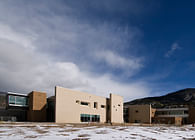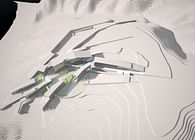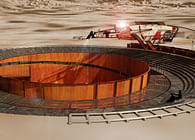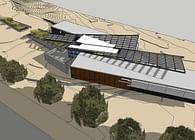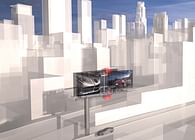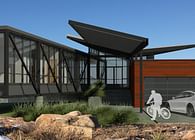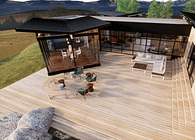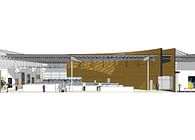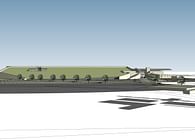
Colorado Springs, CO, US
PROPOSAL FOR REMOTE UNITED NATIONAL SECURITY COUNCIL CHAMBERS
Located within abandoned Titan II B-5 Missile Silo #8, location #571-7, 390th Strategic Missile Wing, Davis-Monthan AFB, Arizona
“We live in a society exquisitely dependent on science and technology, in which hardly anyone knows anything about science and technology.”
- Carl Sagan
Design Abstract: The Titan II Missile Silo Complex serves as a commemorative symbol of both the failure of Cold War diplomacy and our fear of technology. Being both personal and social, this fear characterizes the modern psyche of post-industrial man. As an object the Silo carries with it the remembrance of a time and place when fears of global destruction hinged on minute-by-minute negotiations between Super Power Nations.
The Titan II Missile Silo Project is emblematic of architecture’s potential to symbolically charge and insert meaning into an inert, outdated facility through the potential of adaptive reuse. The proposal here is to symbolize that the lunacy of the Cold War and the lessons that were learned within this era can now serve as the foundation for an attempt to truly achieve a sense of applied reflection and informed honesty in diplomacy. Through it’s aggressive yet poetically-made point that architecture can convey meaning and modify behavior, it acknowledges that communication is the ultimate tool that can achieve this state and that it is only within this context that true understanding can exist.
It is ironic that the remains of one of the greatest destructive weapons that Mankind has ever produced, a device that in its time achieve its rather short-sighted goals of national security, be renewed to serve as a place where events can occur allowing the achievement of this goal in a more rationally evident manner. Though the Titan II was an technologically sophisticated machine with a less than sophisticated goal, in its remnants a true acknowledgement of the potential of diplomacy could take place. Diplomacy is not as technologically advanced as the weapons of the Cold War, but it can none-the-less contain a greater potential for success. As in epochs past, the architectural endeavor can again show its possibilities to create places that clarify and aspire to achieve even the loftiest of our ideals.
Project Execution: The project re-inhabits an abandoned Titan II Missile Silo Complex, converting it’s existing spaces, previously used to house and deploy nuclear arms, into remote UN Security Council Chambers, to used for efforts of international peace and diplomacy - a different kind of ‘deterrent’.
As a prototype, the project is proposed to be repeated at similar facilities located in Germany, Turkey, and Israel, thus making the UN Security Council truly international in both it’s applicable and political environments.
Located in the remote location of a desert military installation, the Silo itself reflects the daunting isolation of its surroundings as well as its past purpose. The facility is designed to suggest our need to abstract what we call ‘normal’, and to signal a change in thought and approach to the daily routines of it’s occupants. Processional qualities become important as incidents are revealed, becoming indicators of a greater narrative.
The glass tower represents a commemorative landmark that at once grounds the project and also demarcates it’s within the landscape. Acting as a referential icon, the tower conjures fearful images of a missile launch or the singular energy glow from a nuclear detonation. Inversely, it is also referential as a beacon of hope in a dark sea of fear, or as a voice of reason in a time of great madness.
The silo itself becomes individual meeting chambers, each affording a view to the Atrocities Wall - constant reminders of what happens when diplomacy fails.
Buried within the Earth, the former control chamber transforms into the Assembly Council Chambers. Round skylights let in filtered light, but have the faint memory of bullet holes.
Silo History Brief: The Strategic Missile Command System was designed, constructed, and commissioned under the Eisenhower Administration as part of a national defense program. The Titan II weapon system was first activated in 1962. As a result of arms and nuclear reduction treaties, the Titan II weapon system was deactivated in the mid 80's. All but two Titan II sites have been dismantled. Site #571-7 in Green Valley Arizona, just south of Tucson, and another located at Vandenberg Air Force Base, California are all that remain in the continental US. Other sites exist in Turkey, Germany, and Russia.
Current Needs: The United Nations (UN) headquarters is currently housed in New York City. This facility accommodates almost all UN activities, functions, and meetings. Problems associated with the current facility include: 1) security concerns for the UN, as it is solely housed at this single location, 2) security concerns for New York City, as the UN is easily accessible (as proven by 9/11) with limited military protection, 3) it does not promote a sense of espirt décor by providing various countries the ability to ‘host’ the UN delegates, and 4) it is often remote from the areas of concern.
Current Silo Status: The United States currently has four viable silos to be utilized. Only one, however, is needed for each county. While the United States Government originally owned each silo facility, many have either been sold by the government to private enterprises or have been destroyed. Each silo that remains is currently monitored by the Russian government via satellite. Public money is no longer spent on operational or maintenance efforts.
Proposed Site: Abandoned Titan II B-5 Missile Silo #8, location #571-7, 390th Strategic Missile Wing, Davis-Monthan AFB, Arizona. Originally constructed from February 2, 1961 to October 25, 1962. Currently adjacent to and monitored by Davis-Monthan AFB (active) and serviced by military air fields.
Program: Provide full facilities for a remote UN Security Council to include Assembly Chamber, Conference Center, Food Service, Council Meeting Rooms, and Research Library into an existing Titan II B-5 Missile Silo. UN guest and council members housing is to be from the remote Davis-Monthan AFB with secured travel to and from the facilities provided by military escort. The prototype design is to be executed at various abandoned missile locations in US, England, Italy, Germany, USSR, and Turkey. Each silo is relatively consistent in construction and organization.
Commemorative Walls: Contrasting the destructive intent of the original structure buried deep in the Earth, massive tilted slabs carve voids into the earth with the intent of bringing healing sunlight into the facility. The slabs act as a literal reference to the 70-ton hatch doors that once protected the facility from possible nuclear attacks. The doors are now folded into the earth to provide protection through memory and commemoration.
The slab at the entry vestibule is etched with the names of World Peace Leaders; the slab at the missile silo is etched with the names of Atrocities against Human Kind.
The names on each of these walls are surrogates for the new intent of peace and communication, a contrast to the former intent of destruction and distrust, and hopefully a reminder of the social compacts of responsibility yet to be forged.
Sustainability Abstract: Architecture always is, as it always has been, a reflection of the intents and values of the culture that creates it.
Perhaps the greatest act of ‘sustainability’ we can employ in architecture is a good, long, hard look at ourselves in the mirror - asking ourselves to stop the internal dialogues just long enough to look around and realize that our built environment absolutely reflects our intents and values.
The Titan II Missile Silo Complex is designed to employ all known ‘best practices’ available to this project, and it will perform with great and somewhat obvious energy-efficiency and prowess, but it’s greatest statement herein is it’s ability to create a moment of repose followed by reflection about our intents and values, and that perhaps ‘sustainability’ should be a concept meaning ‘responsible on all levels’.
We must realize that this we are at a current place where, for the first time in human history, the word ‘ethics’ is being applied to more than solely human interest. This project makes the statement that perhaps architecture should likewise employ a broader calculus of consideration, and begin to make us more aware of not only our human needs, but our humanity as well.
Status: Built
Location: Tucson, AZ, US
My Role: Principal, Lead Project Designer, Lead Project Architect
Additional Credits: Brian Elyo, Ryan Ekstrom, Richard Mapes, Kenny LaGreca (structural engineer)


